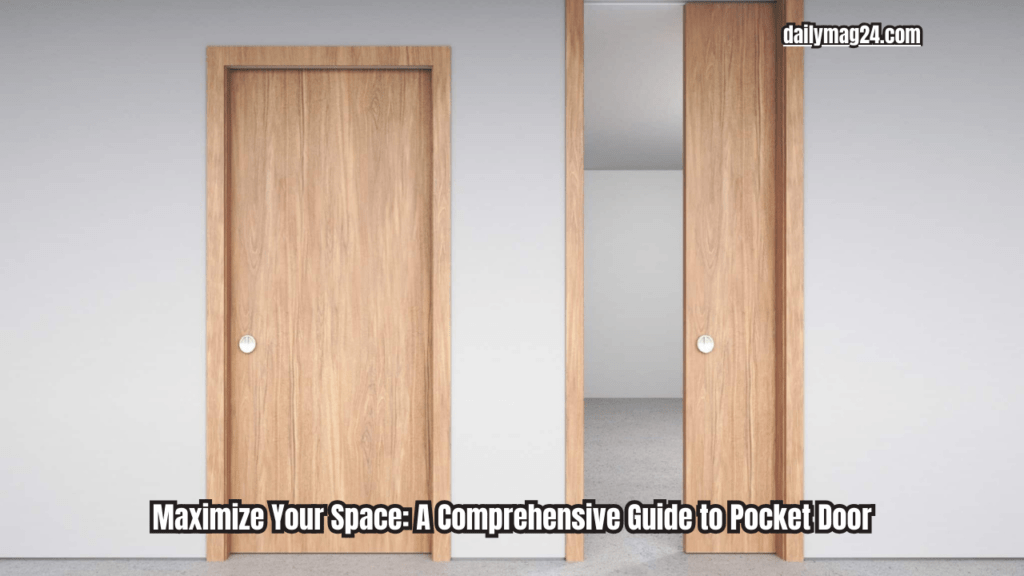Pocket doors are an innovative solution designed to maximize space and enhance functionality in both residential and commercial settings. Unlike traditional hinged doors, which require a clear swing area, pocket doors slide seamlessly into a cavity within the wall when opened. This sleek design not only frees up valuable floor space but also creates a streamlined, modern look that can complement various interior styles. Perfect for tight spaces or high-traffic areas, pocket doors offer a versatile and practical alternative to conventional door systems, allowing for improved flow and accessibility while maintaining aesthetic appeal .
What Are Pocket Doors?
Pocket doors are sliding doors that retract into a concealed wall cavity, making them disappear from view when open. This design eliminates the need for a door to swing open, which can be particularly advantageous in tight spaces or high-traffic areas.
History of Pocket Doors
Pocket doors have a storied history, emerging in the late 19th century during the Victorian era. Initially designed to address space constraints in densely populated urban areas, they quickly became popular for their ability to enhance the flow of natural light and create a more open, airy feel in homes. Their popularity has persisted due to their timeless functionality and aesthetic appeal.
Benefits of Pocket Doors
Space Efficiency
One of the most compelling advantages of pocket doors is their space-saving design. Traditional hinged doors require additional space to open, which can be a significant constraint in smaller rooms or areas with limited clearance. Pocket doors, by sliding into the wall, maximize usable floor space and reduce clutter.
Aesthetic Versatility
Pocket doors offer a modern, streamlined look that can seamlessly integrate with various interior styles. They can be customized with different materials, finishes, and hardware to suit both contemporary and traditional decor. Whether you prefer a minimalist design or something more ornate, pocket doors can be tailored to meet your aesthetic preferences.
Enhanced Flow and Accessibility
With no swinging arc to navigate, pocket doors facilitate smooth transitions between rooms. This feature is particularly useful in high-traffic areas or spaces where accessibility is a priority. Pocket doors can also be an excellent solution for people with mobility challenges, as they require less effort to open and close compared to traditional doors.
Versatility in Application
Pocket doors are incredibly versatile and can be used in various settings. Common applications include:
- Room Dividers: Create flexible spaces by using pocket doors to separate or combine rooms as needed.
- Closet Doors: Optimize closet access without sacrificing space.
- Bathroom Entryways: Maintain a sleek look while providing convenient access to bathrooms.
- Pantry Doors: Keep kitchen areas organized and accessible.
Types of Pocket Doors
Single Pocket Doors
Single pocket doors consist of a single panel that slides into one wall cavity. They are typically used in smaller openings or where space constraints are minimal. Single pocket doors are ideal for smaller rooms or single-entry closets.
Double Pocket Doors
Double pocket doors feature two panels that slide into opposite wall cavities. This configuration is suitable for larger openings, such as those leading into living rooms or dining areas. Double pocket doors provide a grand entrance and can enhance the sense of space and openness.
Bi-Fold Pocket Doors
Bi-fold pocket doors consist of two or more panels that fold in half before sliding into the wall cavity. This type is useful for wider openings where a single or double door might be impractical. Bi-fold doors offer flexibility and ease of use in spaces requiring frequent access.
Installation Process
Planning and Preparation
- Measure the Opening: Accurate measurements are essential for a successful installation. Measure the width, height, and depth of the opening, as well as the wall cavity depth where the door will slide into.
- Choose the Door Size and Style: Select a door size and style that fits your needs and complements your interior decor. Consider factors such as door material, finish, and hardware.
- Prepare the Wall Cavity: Ensure the wall cavity is clear of obstructions and is deep enough to accommodate the pocket door. This may require removing existing drywall or making modifications to the wall structure.
Installation Steps
- Install the Track System: Attach the track system to the top of the door frame. This system includes rollers that guide the door as it slides open and closed. Ensure the track is level and securely fastened.
- Hang the Door: Mount the door onto the track system. Test the door’s movement to ensure it slides smoothly and evenly. Adjust the rollers if necessary to achieve a proper fit.
- Finish the Wall: Install drywall or other wall coverings around the pocket door. This step involves framing the wall cavity and finishing the surface to create a seamless look.
Professional vs. DIY Installation
While installing a pocket door can be a DIY project for those with experience in carpentry and home improvement, professional installation is often recommended. A professional installer can ensure precise measurements, proper alignment, and smooth operation, minimizing the risk of complications.
Design Ideas for Pocket Doors
Modern and Minimalist
For a modern, minimalist look, choose a frameless pocket door with clean lines and a simple design. Opt for materials such as glass or high-gloss finishes to enhance the sleek appearance. This style works well in contemporary interiors where a clutter-free aesthetic is desired.
Rustic Charm
Embrace a rustic or farmhouse-inspired look with pocket doors featuring distressed wood finishes or barn door hardware. Incorporate elements like sliding barn door tracks or decorative hinges to add character and warmth to the space.
Glass Pocket Doors
Glass pocket doors can create a sense of openness and allow natural light to flow between rooms. Choose frosted or clear glass depending on the level of privacy required. Glass doors are particularly effective in spaces where maintaining visibility and light flow is important.
Custom Finishes
Customize your pocket door with various finishes, colors, and patterns to match your interior decor. Consider adding decorative elements such as paneling, carvings, or inlays for a unique and personalized touch.
Maintenance and Care
Regular Cleaning
To keep your pocket door in top condition, perform regular cleaning. Wipe the door surface with a damp cloth to remove dust and grime. Clean the track system with a vacuum or compressed air to eliminate dust and debris that could impede smooth operation.
Lubrication
Apply a lubricant to the door’s rollers and track periodically to ensure smooth sliding and prevent squeaks. Use a lubricant specifically designed for sliding doors to avoid damaging the hardware.
Addressing Common Issues
If your pocket door becomes misaligned or sticks, check for obstructions or damage in the track system. Adjust the rollers as needed to realign the door. If problems persist, consult a professional for repairs or adjustments.
Conclusion
Pocket doors offer a blend of functionality and aesthetic appeal, making them an excellent choice for a variety of interior design needs. Their space-saving design, versatility, and modern look make them a valuable addition to both residential and commercial spaces. By understanding the benefits, types, installation process, design options, and maintenance requirements, you can make an informed decision about incorporating pocket doors into your home or office. With proper installation and care, pocket doors can enhance the beauty and functionality of your space for years to come.
Also Read: Exploring the Unique Muppet with long Hooked Beak
FAQs
1. What is a pocket door?
A pocket door is a sliding door that retracts into a wall cavity when open, saving floor space compared to traditional hinged doors.
2. What are the benefits of pocket doors?
Pocket doors save space, offer a sleek look, and improve room flow. They are ideal for tight spaces and high-traffic areas.
3. Can pocket doors be used in any room?
Yes, pocket doors are versatile and can be used in living rooms, bedrooms, bathrooms, and closets.
4. How do I choose the right pocket door?
Select based on the opening size, intended use, and style. Single doors are for smaller openings, while double doors suit larger ones.
5. Should I install a pocket door myself?
While DIY installation is possible, hiring a professional ensures proper alignment and smooth operation.
6. What is involved in installing a pocket door?
The process includes measuring the opening, preparing the wall cavity, installing the track, hanging the door, and finishing the wall.
7. What maintenance do pocket doors require?
Regularly clean the door and track, lubricate the rollers, and check for obstructions or misalignment.
8. Can pocket doors have glass panels?
Yes, pocket doors can feature glass panels, such as clear, frosted, or patterned glass.
9. Are pocket doors durable?
Pocket doors are durable with proper installation and maintenance, including quality materials and regular care.












